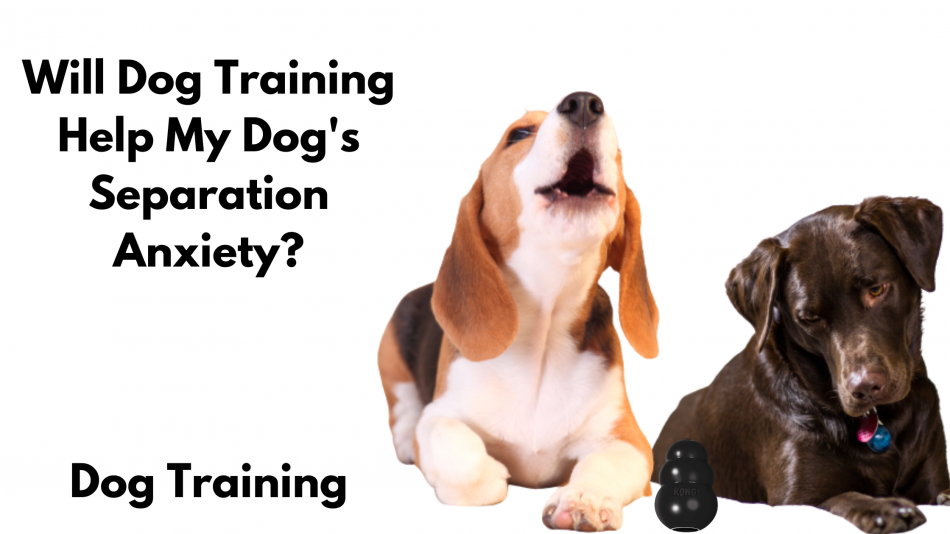
Separation anxiety can be upsetting for many dog owners, and dog anxiety can lead to stress and many other conditions because not all dogs can handle being separated from their owners. But there are great ways to deal with it and make it less of a problem for you and your dog, and this involves dog training. But many dog owners want to know, “Will dog training help my dog’s separation anxiety?”
Yes, dog training is a good place to start, as it can build a solid foundation of obedience and trust between you and your dog. Some of the techniques discussed in this article may seem common sense, but keeping these points in mind will help you leverage them even more.
Whether you have a new puppy or are working with an adult dog that feels lonely when left alone, these tips can help ease your pup’s anxious response to separation.
What Is Dog Separation Anxiety?
Separation anxiety, or SA, refers to a dog’s stress caused by being left alone. When a dog suffers from separation anxiety, it becomes distressed and displays problematic behavior when away from its owner. Within minutes of the handler’s departure, separation anxiety generally begins to show itself. However, it is also important to note that not all dogs suffer from separation anxiety.
Symptoms of Separation Anxiety in Dogs
- This can include destructive behavior.
- Excessive barking when you are away from home.
- Being excessively clingy and demanding to be left alone when you are at home.
- When certain dogs are left alone or separated from their owners, they may urinate or defecate.
- Dogs chew on items, door frames, and window sills when alone or separated from their guardians.
- Digging and chewing through doors and windows, and escapes when left alone or separated from his guardian.
- When left alone, they walk or trot in a regular pattern.
- Some canines are known to ingest their feces after defecating.
This is a very common problem in dogs, usually starting between 6 months and 2 years of age. Separation anxiety can be caused by:
- genetics,
- past experiences,
- health problems.
Dogs left alone for long periods as puppies, or neglected or abused, are more likely to develop separation anxiety in later life. If a puppy has learned that being alone is associated with being left behind, he may be more likely to develop separation anxiety later.
Why Does Your Dog Have Separation Anxiety?
There are a few reasons why a dog would have separation anxiety. A common one is that the dog was left alone too early. Dogs need lots of positive reinforcement when they are little because this is when they are most receptive to training. If you leave a puppy alone too soon, he may get anxious when you leave them again. If possible, wait to leave your puppy alone until he is 6 to 8 months old.
Another common reason dogs have separation anxiety is that they feel trapped inside a crate when you leave them at home. Dogs don’t like being confined, even if they are kept safe. It can be helpful to leave a radio or TV on while you are gone so your dog has some noise to occupy him. If you crate your dog, make it as comfortable as possible by lining it with a blanket and placing a chew toy inside.
How to Fix Separation Anxiety in Dogs
Here is how to help your dog overcome separation anxiety.
Avoid Disturbing Communications
Dogs have a wide range of nonverbal modes of interaction, including vocalizations, scents, facial expressions, and physical postures. If you regularly ignore these, your dog may feel you don’t care about them. This can lead to confusion and even more anxiety, especially if your dog feels something is wrong and you are not paying attention. Regular play sessions and quality time with your dog can help to release stress and make you feel more relaxed.
Spending time with your dog not only helps you to understand it better but also helps to build a bond. It will also make your dog more relaxed and less anxious if they feel you are taking the time to understand and communicate with him.
Learn Your Puppy’s Talking Pattern
Puppies have a very different way of communicating than adult dogs, and many people are unaware of the signs a puppy gives when feeling anxious or stressed. So if you notice your puppy is acting differently, it may be because he is anxious. Puppies use a lot of play biting and mouthing, but this is a way for them to learn about their world.
If your puppy bit you too hard, you must stop the behavior. If you scold your puppy or push the mouth away, the puppy will become more anxious and stressed and have no idea why. Instead, try to ignore the biting and talk to your puppy in a soothing voice.
Train Your Pet for Good Behavior
If your dog is experiencing anxiety, this is a terrific approach to calm him down, especially if he is a new addition to your family or a puppy. Correcting your dog’s behavior is now within your sight. This is important to your dog’s future and will help him to be less stressed. For example, if your dog is barking excessively when you are out of your home, you must correct this as quickly as possible.
This can be done using a water sprayer, but it is also very effective to train your dog to sit on command. Once your dog has mastered this, you can use it to stop him from barking. This is when dog training becomes necessary. There are different types of dog training methods you can use.
What Are The Different Types of Dog Training Methods
- Positive Reinforcement: This is simple in theory when a treat is given after a good deed, and dogs are more likely to repeat it. However, neither positive reinforcement nor acceptance is given for negative actions. When necessary, a punishment is implemented by withholding positive reinforcement, such as taking away a toy or some goodies. In most cases, a stern lecture or a smack on the wrist will suffice as a form of discipline.
- Clicker Training: A form of positive reward called “clicker training” is grounded in the same principles of operant conditioning. One possible classification of clicker training is as a form of positive reinforcement rather than training.
- Electronic Training: During electronic training, a dog wears an electric collar that, if it deviates from the expected behavior, either shock it or sprays it with citronella. Its primary function is remote training, where a leash would be impractical.
- Model-Rival: The model-rival or mirror training method is predicated on the idea that canines pick up information through observation. Dogs pick up new habits by watching their owners and by competing with one another for food and other resources.
- Alpha Dog Or Dominance: Using the dog’s natural pack mentality, alpha dog or dominance training establishes a hierarchy based on obedience and submission. Based on social orders within wolf packs, the hypothesis proposes that domesticated dogs also view their families as packs and adhere to such norms. Therefore, dogs who believe they are the pack leader must learn to recognize and submit to their human alpha instead.
- Relationship-Based Training: Relationship-based training incorporates several approaches to canine and human education, emphasizing customization. Everything revolves around the bond between a dog and a human.
What is a Dog Training Course?
When owners enroll in a dog training school, they will learn how to properly and effectively train their dogs systematically. These classes run for many weeks and can be held in a classroom or through a virtual medium. Experts may disagree on how to train a dog, but they can agree on several fundamentals. Regardless of the pedagogical approach, these principles are standard in any dog training curriculum.
Brain Training for Dogs – A Unique and Effective Dog Training Course is a good and recommended example of a dog training course.

Classes for dogs typically focus on teaching the dog to:
- What to do when bringing your dog to a new home or park for the first time
- Using positive reinforcement: A Step-by-Step Guide
- Training methods for reducing problematic conduct
- Learn the ins and outs of leash walking with your dog.
Conclusion
To answer the question, “Will dog training help my dog’s separation anxiety?” Separation anxiety can be upsetting for many dog owners, but there are great ways to deal with it and make it less of a problem for you and your dog. Dog training is a good place to start, as it can build a solid foundation of obedience and trust between you and your dog. Some of the techniques discussed here can help with dog separation anxiety, but keeping these points in mind will help you leverage them even more.